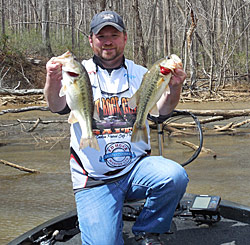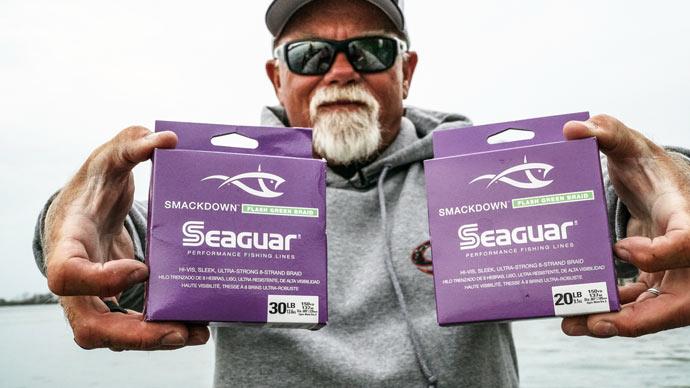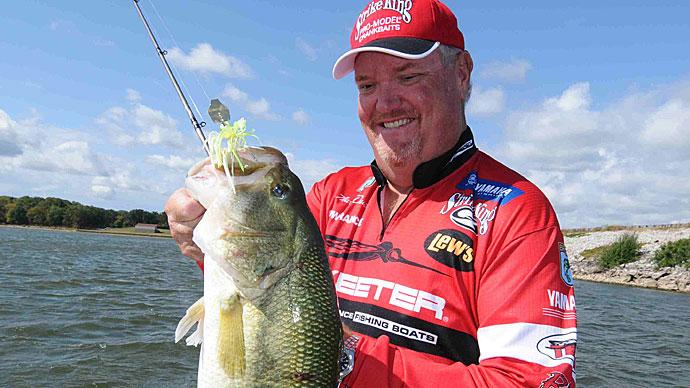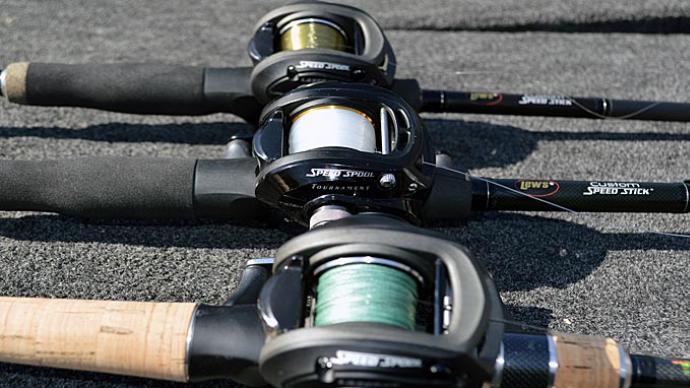
About an hour before leaving for weigh-in, I had one little dink in the livewell. I'd been casting this crankbait o long that I was sure I would be sore when Tuesday got here. We had pre-fished the day before the tournament and had talked. A friend "owed" me some information because I had shared my pattern with him at the last lake we had fished. He showed me precisely the crankbait that had worked on the pre-fish day. I verified this by seeing the teeth marks and missing paint. He even gave me part of the water and said there was plenty of fish for us. A fellow can't have a better friend than this. As I said, I had watched him throw this particular Bandit medium-diving crankbait and catch fish on it all day. He finished in second place that day, and while we both tried to figure out what I was doing wrong, I asked him what size line he was using. He said, "You know I never use anything heavier than 10 pounds in the spring when the water is this clear."
We used 7-foot rods, medium action, Shimano reels, and the same crankbait. Not to speak of the extra 15 yards in the distance he gained by using the 10-pound line. It's all in the diameter of the line and how much resistance it has with the water. His crankbait had been ticking the top of the grass in 12 feet of water, and the fish were in the grass. They wouldn't go the extra two feet toward the surface to get my lure. I had made the wrong line selection.
At the other end of the spectrum was the trip to Sam Rayburn, pre-fishing for a team championship tournament held there a few years back. Unfortunately, neither my partner nor I knew how to catch the fish in the grass that everyone had talked about for two months before the tournament. So we sprung for a guide trip two weeks before the cutoff date. Using a local guide on a foreign lake is a common practice for tournament fishermen. It teaches you the technique and shows you what pattern will work, and all of the guides I've ever fished with have been more than helpful as to what they think it will take to win. The only drawback is, don't try to use the exact water he fishes because chances are you are not the only one that knows where his fish are. Instead, use what he teaches you and find your own water similar to his in as many ways as possible.
Okay, back to the line size lesson. He told me to bring a Carolina rig, a wacky worm rig, and a good stout rod. We started the day catching a few wacky worm fish out in the sparse grass beds scattered outside the main grass mat. I had 12-pound test on that rod, and it worked fine. For the rest of the day, I got to feel the bites but never saw the fish he said it would take to win the tournament. He was rigging a giant salt craw on a 5/0 hook and a 1/2-ounce worm weight or a 3/4-ounce black, blue, purple jig with the back half of a salt craw on it for a trailer. He would nose the boat up on the edge of the grass and pitch at the tiniest holes in the mat. He would feed the jig enough line to let it go to the bottom, jig it twice, pull up, and pitch to another hole. He had two big fish in the boat in less than 30 minutes and said, "I just wanted to show you they were here." Then we left. He was fishing a brand of that fancy spectra-fiber in 50-pound strength that I couldn't make myself put on my reel.
I rigged up a 7-foot jig rod for the tournament with about the same action as a pool cue. I had dug out one of my old Ambassador 5000 C's from the late 70s, cleaned her up, put it on my pool cue, tightened down the drag with a set of industrial vise grips, spooled up with 20-pound mono, and I was ready.
We started tournament morning with a plastic twitch bait I had found to work, then caught one more fish on that blamed wacky worm. So we had three fish in the livewell. It was 10:00 a.m. and time to go to the jig fish and put a couple of kickers in the box.
We went to the guide's water, and no one was in sight. I nosed the boat to the mat and hadn't been fishing for 10 minutes when the first fish bit. As instructed, I set the hook, held her head up, and brought her to the top. I saw her head before she turned, and straight down she went. That 20-pound line sounded like a 22 rifle shot when it broke. After a thorough butt chewing from my partner, I settled myself down from that and decided I would not put quite as much pressure on the next fish.
Okay, it's 11:30; I've got plenty of time to catch two more fish, so back to work I go. The next fish that bit took the salt craw and headed to China before it sank two feet. I reared back and set the hook, but I didn't pull quite as hard on her as I had the first one. Unfortunately, she made a big circle under the water before I got her up, and there was no way to get her and three square yards of hydrilla in the boat.
I had now lost two good fish that might not have won the tournament but would have surely got us a nice check, all due to my line size selection. Instead, we had driven 400 miles, rented a room for four days, bought a guide, and blew a tournament, cause I didn't consider line size.
I've made these two examples, but we haven't even considered underwater visibility yet. If you fish in clear water, you are constantly aware of whether or not the fish can see the line under the water. If I can see the line under the water, so can the fish. I don't, and won't use, florescent coated lines because the ultraviolet light that makes line florescent penetrates water to a certain depth. I know you boys that fish root beer-colored water or muddy water 80 percent of the time don't understand this, but anything we can do to keep the fish from knowing whether our lure is real matters. For me, this is a confidence thing, and confidence is one of the essential tools in your boat. If you are confident with line that you can see, this is your choice.
There are as many brand names of line these days as there are lure companies, and each of us has our favorite, but take a new look. They have all made an effort to improve their products. The newest trend is in the fluorocarbon market. The chemical structure of fluorocarbon is that underwater, it disappears. Pure fluorocarbon line is strong, has a little stretch but tends to be stiff, and has a bit too much memory "slinky action" for me, not to mention the cost. However, a few line manufacturers have found a way to put a fluorocarbon coating on their line achieving the advantage of being invisible underwater without the bad characteristics of the pure stuff.
Fishermen's views of braided lines are much like spinach. You either love it, or you hate it. Braided line has also made many advances since first introduced a few years ago as a sort of hybrid kite string. It was costly when first introduced and was suspected to be hard on equipment. In certain situations, it would not break and have no stretch, but if you didn't tie the right knot would "untie" itself from your lure. Nevertheless, it became very popular with muddy-water fishermen and people who fished in heavy weed beds or heavy wood cover. The manufacturers have made improvements here, too. They have made the line easier to tie a knot in, are available in many different colors yet still able to keep the no-stretch, no-break advantages, and are not as abrasive on fishing equipment.
The bottom line is line choice does matter, and we all have to be versatile enough to pick the right line in the right situation every time we go to the water. It's straightforward, read the information about each type of line and use the qualities it has to apply to your fishing techniques; you will be much better off in the long run. Pay attention to what other people tell you about the types of lines they use, and don't forget some rod manufacturers even recommend the proper pound tests for specific rods, which is a big help.
I hope this has helped you see you do have the ability to create your own luck.




